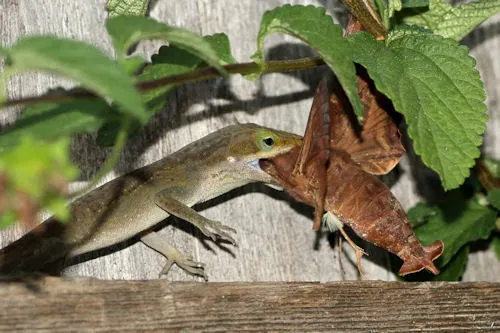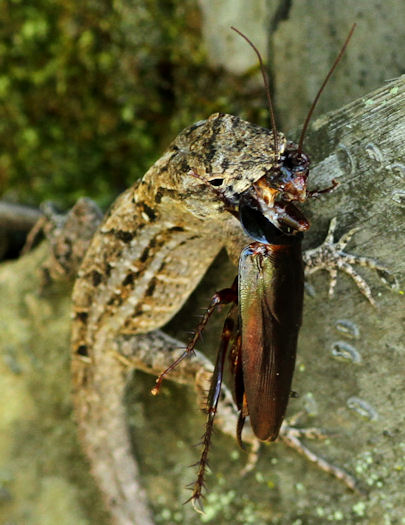The photograph above from Daffodil’s Photo Blog shows a brown anole that has just caught a roach almost as big as itself. The lizard was actually able to run away with its prey, so we don’t know if it was consumed.
 This, in turn, reminds us of a previous post of DFB in which a green anole again caught a really large prey item, in that case a moth, but again the outcome was unknown.
This, in turn, reminds us of a previous post of DFB in which a green anole again caught a really large prey item, in that case a moth, but again the outcome was unknown.
Imagine eating a Big Mac 80% of your body weight. Think how long you could run on that, and you’re warm-blooded–lizards have a much lower metabolic rate. How often do anoles get this bonanza? Certainly, most of their prey items are quite tiny in relative terms. And how often do they catch prey that they ultimately can’t ingest? There is a lot of data on anole diets in the literature, but no one has every synthesized it to see what general messages can be extracted, what broader questions–such as this one–can be addressed. Would make for an interesting project.
- New Article on Anolis roosevelti and the Question of Its Survival - March 16, 2024
- Lizard Diving Champions: Trading Heat For Safety Underwater - March 15, 2024
- Do Large Brown Anoles Get the Most Mating Opportunities? - January 6, 2024



Skip (James) Lazell
Actually, “… there are a lot of data….” Sorry old friend, just being pedantic. Best, Skip
Jonathan Losos
Not sure that I agree, Skip. Certainly, “data” is plural, but a “lot” is singular. Any grammar mavens out there?
Jonathan Losos
Skip, after more consideration and discussion at dinner, I agree that you are right. “A lot” has become the equivalent of “many” and “few,” which are plural, unless you are referring to a specific “lot.”
Armando Pou
On multiple occasions I’ve observed Anolis capture and consume very large insect prey. They grab hold of the insects by the head and then proceed to “bash” them from side to side, often scraping off wings and legs against a hard surface, but managing to swallow the softer central body components. The bashing process is similar to what birds do, except they do it to make sure the prey is dead or rendered immobile.
Armando Pou
Just another thought, the size of the prey may also depend on the species of Anolis. Although I have witnessed sagrei, cristatellus and carolinensis consume large palmetto bugs (roaches), grasshoppers, moths, and dragonflies, I’ve never seen distichus do the same (even larger males) who seem content to pick off whiteflies, gnats, fruitflies and ants by the dozens at a sitting.
Bill Bateman
Just watched a smallish sagrei female demolish a palmetto roach considerably bigger than herself. She battered it and wiped it on the decking for ages but in the end only ate the abdomen, leaving the rest broken up and scattered. Just checked on her again: she is now sitting on the rim of the dog’s water bowl, gasping with exhaustion.
Nathan Turnbough
I’ve seen adult male sagrei consume cicadas (the big, hard-bodied ones) in Florida. In one instance, the cicada had probably recently emerged and was still soft, but in another instance the cicada appeared to be fully mature with a hard exoskeleton (it was able to alarm call, which drew my attention to the lizard). It looked impossible and took forever, but somehow the anole managed to get it down. In a third instance I was again alerted to the interaction by the cicada’s alarm call, but the cicada eventually escaped, possibly because I disturbed the anole with my approach.
Karen Cusick
Nathan’s comment about sagrei eating cicadas reminded me of the male sagrei I once photographed with a cicada. The anole carried the cicada along the fence, eating it on the way, and finished off all of it including the wings.
Martha Muñoz
I didn’t know that anoles beat up large prey to eat them! That’s so cool! As much as cockroaches make my skin crawl, someone should upload a video of this. Armando and Bill – I’m looking at you! 🙂